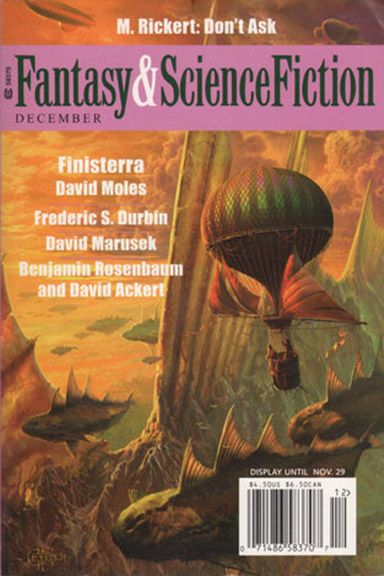
F&SF, Dec 2007. Cover illustration by Cory and Catska Ench.
Finisterra
In The Magazine of Fantasy and Science Fiction, December 2007. Reprinted in The Year’s Best Science Fiction: Twenty-Fifth Annual Collection, edited by Gardner Dozois. New York: St. Martin’s Griffin, 2008. ISBN 978-0312378608 (tpb), 978-0312378592 (hc). Reprinted in The Mammoth Book of Best New SF 21, edited by Gardner Dozois. London: Robinson, 2008. ISBN 978-1845298289 (tpb), 978-1849015301 (ebook). Reprinted in Clarkesworld 79, April 2013. Reprinted in Twenty-First Century Science Fiction, edited by David G. Hartwell and Patrick Nielsen Hayden. New York: Tor, 2013. ISBN 978-0765326003 (hc), 978-0765326010 (tpb), 978-1429988742 (ebook). London: Robinson, 2013. ISBN 978-1472112422 (tpb) Reprinted in Space Opera, edited by Rich Horton. Gaithersburg: Prime, 2014. ISBN 978-1607014072 (tpb), 978-1607014232 (ebook).The men of the Nazario family have been aeronautical engineers for eight generations, sought by the wealthy moros of Rio Pícaro, and even by the extrañados returned to Earth from the stars.
But Bianca Nazario is a woman. And whatever the moros might permit among themselves, the Christians of Rio Pícaro allow no women to enter the Engineers’ Guild.
When the extrañados bring a contract for a Spanish-speaking aeronautical engineer to travel a very long way from Río Picaro and be paid a very large sum of money, the Engineers’ Guild knows it’s too good to be true. The ayuntamiento knows it’s too good to be legal.
Here on the world called Sky, where the cities hang from vacuum balloons and living islands sail the clouds, with a bootleg copy of her father’s engineering system in her valise and nothing but a thousand kilometers of air under her feet, what Bianca Nazario knows is that it’s her only chance.
When the charges the drilling teams had planted went off, a ripple went through the zaratán’s body, a slow-motion convulsion that took nearly a minute to travel down the body's long axis, as the news of death passed from synapse to synapse; and Bianca saw flocks of birds started from the trees along the zaratán's back as if by an earthquake, which in a way she supposed this was. The carcass immediately began to pitch downward, the nose dropping the result, Bianca realized, of sphincters relaxing one by one, all along the zaratán’s length, venting hydrogen from the ballonets.
Then the forward edge of the keel fin hit the ground and crumpled, and the whole length of the dead beast, a hundred thousand tons of it, crashed down into the field; and even at that distance Bianca could hear the cracking of gargantuan bones.